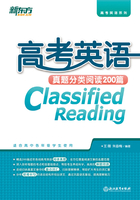
Passage 46
(2006 江苏 D)
In a recently published book, I came across some exercises with interesting names such as fishbone diagrams, lotus flowers, and clustering.As I used these exercises in my classes, I noticed that students were interested. They said more and wrote more.They enjoyed expressing their ideas and sharing them in groups.They were no longer passively waiting for the bell, but actively took part in the lesson.I find that creativity (创造性)can act as a way to increase participation and improve fluency (流利程度).
creativity has become a popular word in recent years.Scholar in the arts, psychology (心理学), business, education, and science are all working to get a deeper understanding of it.Robert J.Sternberg is a creativity specialist and Yale professor of psychology.He defines creativity as “the ability to produce work that is both new (original)and appropriate (applicable to the situation)”.This definition is useful, as we want our students to use language in a new way, and to use it correctly and properly.Most scholars say there are two types of creativity: big “c”creativity and small “c”creativity.big “c”creativity refers to genius level thinking that results in artistic masterpieces and scientific breakthroughs.Small “c”creativity refers to everyday level thinking that can be used in any situation.Our emphasis is on the latter.While it goes without saying that any of our students could go on to be the next Picasso or Edison, our aim is to help students produce more ideas and use language in new ways.
1.The underlined words “waiting for the bell”in the first paragraph probably mean ______.
A. longing for a phone call
B. hoping to have a bell
C. expecting the end of the class
D. wanting to speak in class
2.It can be inferred from the Passage that the author thought the exercises in the book were ______.
A. popular
B. useful
C. scientific
D. creative
3.When you use a very familiar word in a new way, you are ______.
A. creative in the sense of big“c”creativity
B. creative in the sense of small“c”creativity
C. not creative in the sense of big“c”creativity
D. not creative in the sense of small“c”creativity
4.The main purpose of the Passage is to ______.
A. show how useful the book is
B. explain what creativity is
C. discuss how one can be creative
D. tell what teaching aims at
【重点词汇】
come across 偶遇
fishbone diagram 鱼骨图
clustering n.聚类
passively adv.被动地
participation n.参与
scholar n.学者
specialist n.专家
masterpiece n.杰作
breakthrough n.突破
emphasis n.重点
latter adj.后面的
【疑难长句】
big “c”creativity refers to genius level thinking that results in artistic masterpieces and scientific breakthroughs.
refer to“指的是什么”;genius level thinking “天才水平上的思维”;result in“导致”;artistic masterpieces and scientific breakthroughs“艺术杰作和科学的重大进展”。
(参考译文)bIG “c”创造力是指能够产生艺术杰作和科学重大突破方面的天才水平的思维。